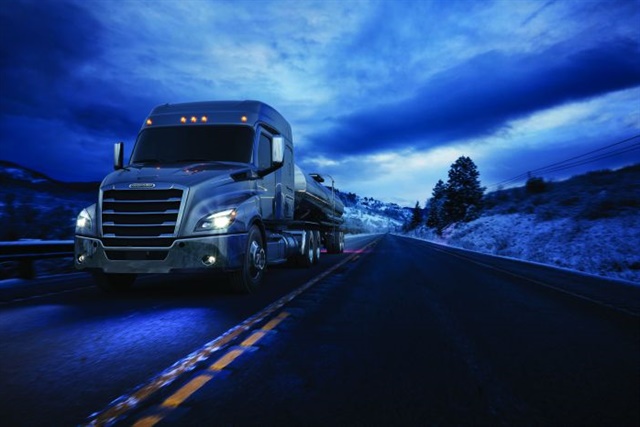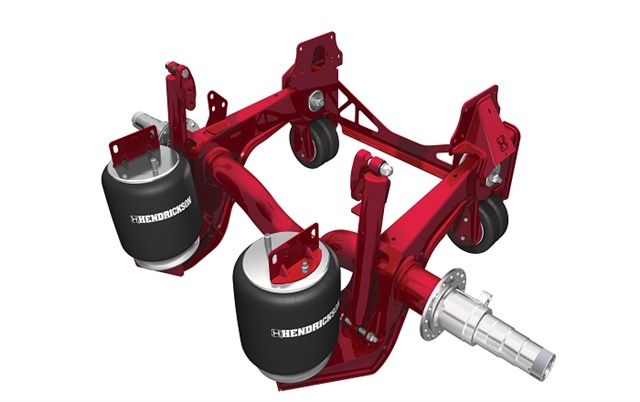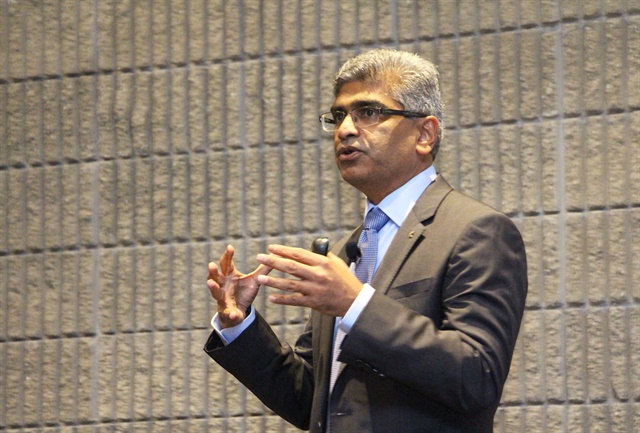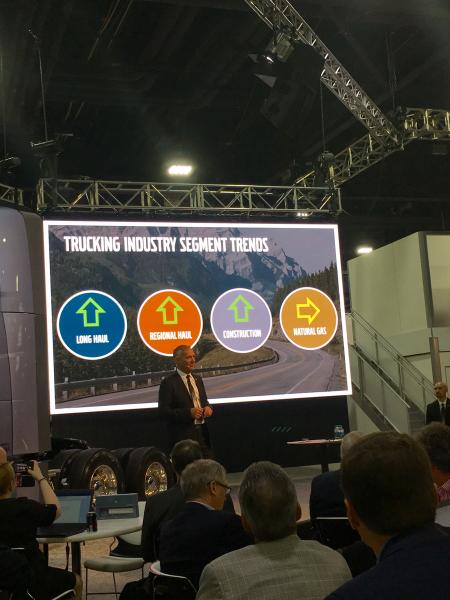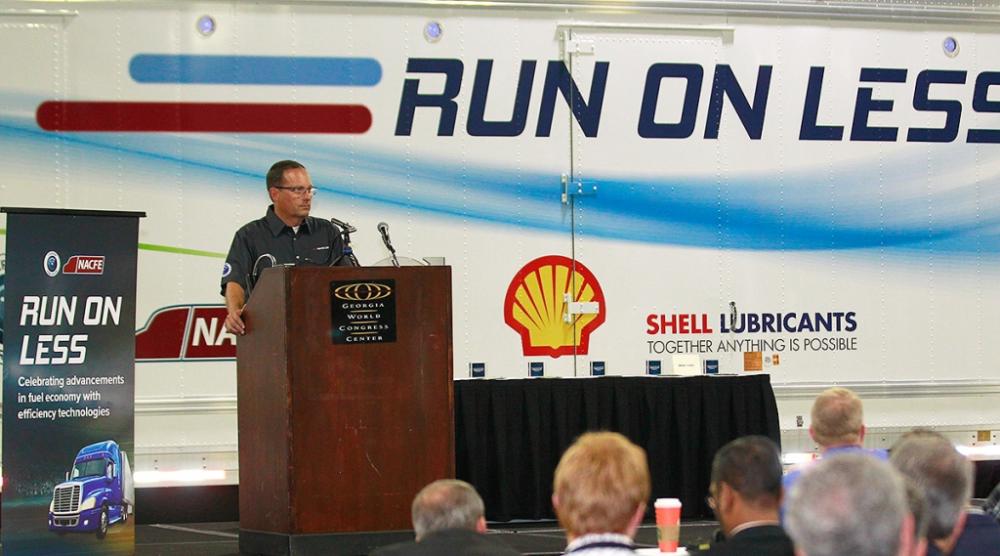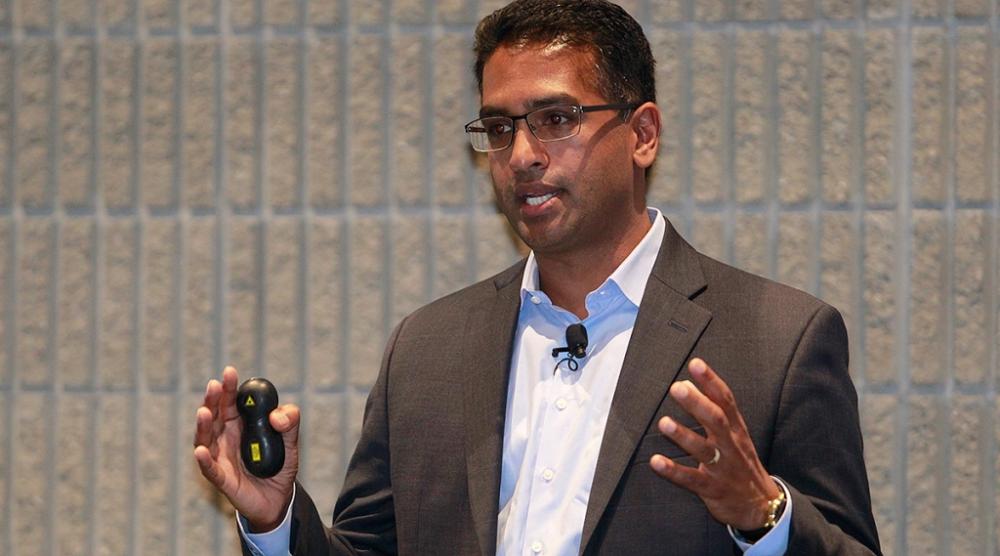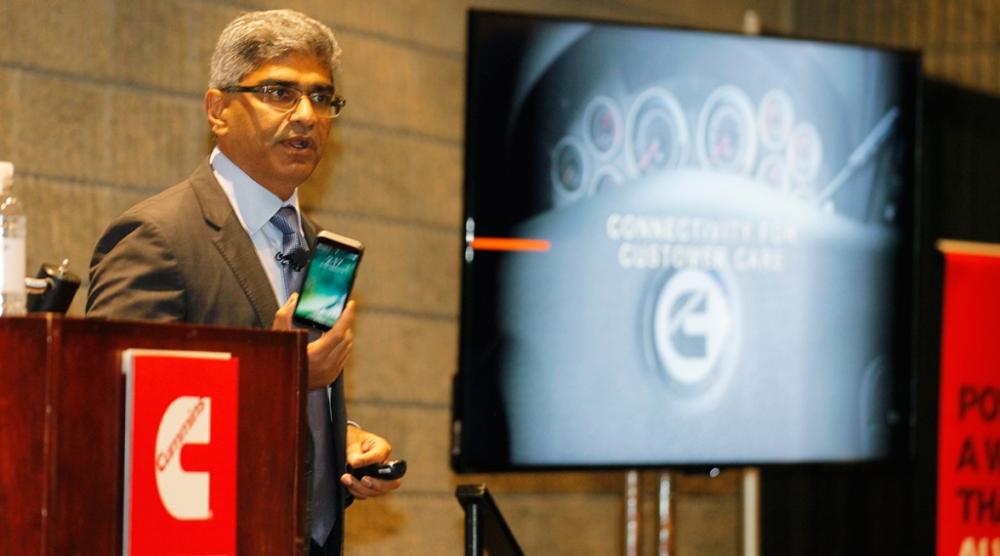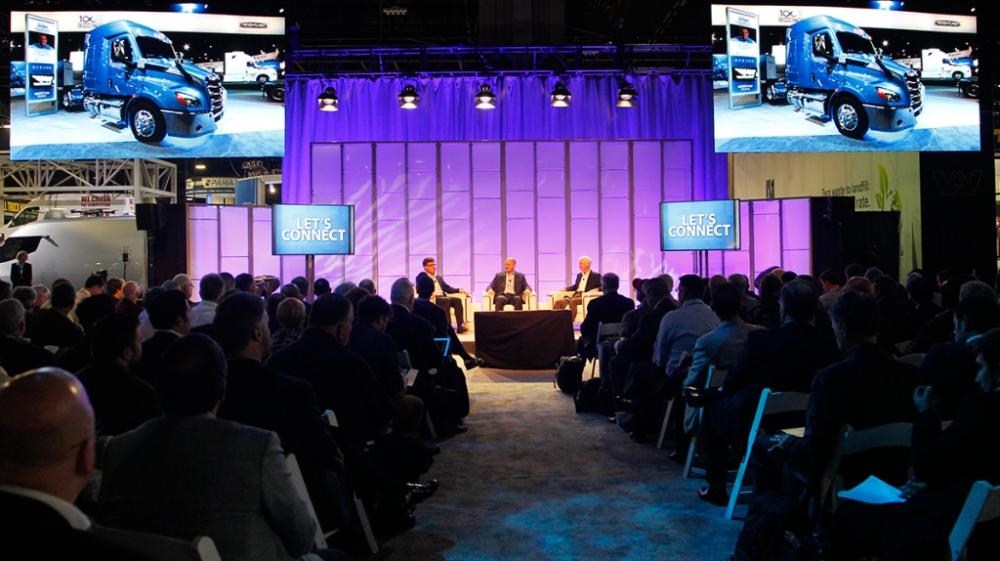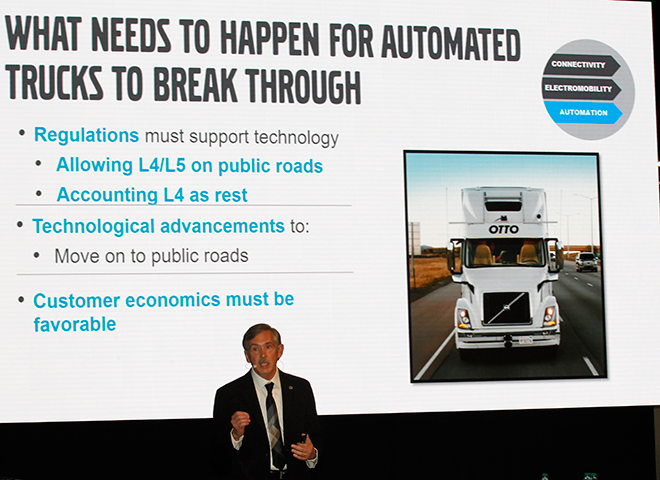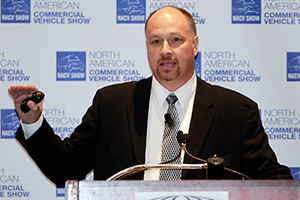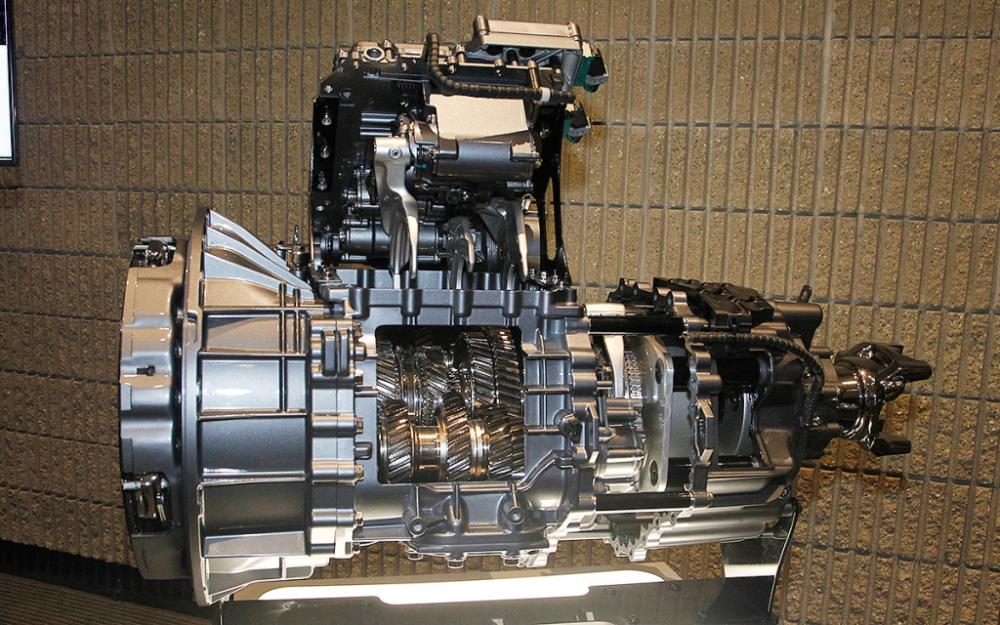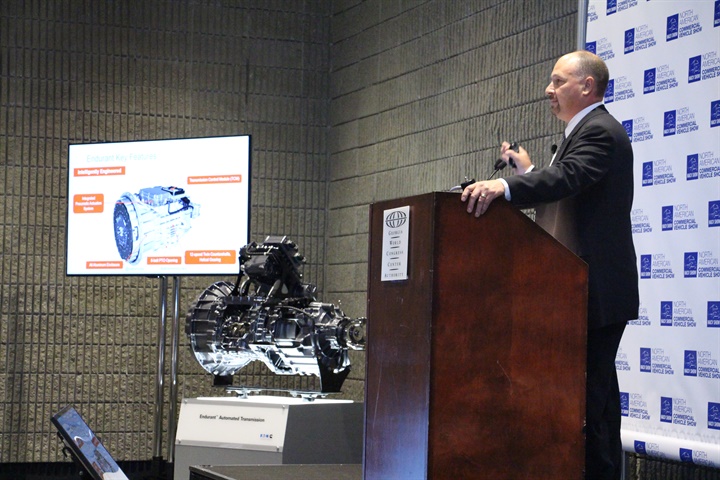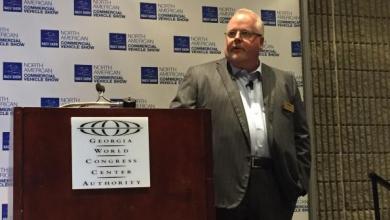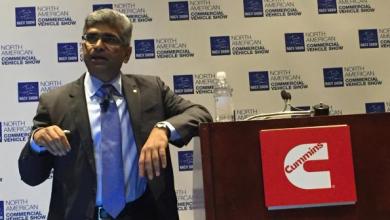
kscarbel2
Moderator-
Posts
18,868 -
Joined
-
Days Won
114
Content Type
Profiles
Forums
Gallery
Events
Blogs
BMT Wiki
Collections
Store
Everything posted by kscarbel2
-
Heavy Duty Trucking (HDT) / September 25, 2017 The Freightliner Cascadia is now available in mid-roof cab configurations for regional overnight haulers and segments such as bulk haul and flatbeds, the company announced at the North American Commercial Vehicle Show in Atlanta. The configurations include 48-, 60- and 72-inch mid-roof XT sleeper cabs in both 116- and 126-inch BBC platforms. All three configurations offer two levels of aerodynamic packages, the Aero or AeroX, Freightliner’s most fuel-efficient specification. The new configurations are available to order now, for delivery in Jan. 2018. “The addition of the mid-roof configuration allows more customers in different applications to experience the benefits of the new Cascadia,” said Mike McHorse, manager, on-highway product marketing, Freightliner Trucks. “Since the new Cascadia debuted in September 2016, it has earned praise as the most productive, efficient and driver-friendly truck Freightliner has ever offered to the industry.” Features of the new Cascadia include: A service-friendly electronic vault (eVault) that offers convenience and protection from the elements while also increasing uptime. The eVault’s central location allows for easy access when troubleshooting most electronic control units. All LED-lit interior and exterior lights, making the lighting system more maintenance-friendly than ever. An ergonomic dashboard and display screen designed for the driver. Its layout helps drivers access gauges and switches without reaching and includes an easy-to-read instrument cluster display. Detroit Connect and Detroit Assurance 4.0 seamlessly integrated into the new Cascadia to offer enhanced fleet management, increased uptime and improved safety. Improved fuel economy compared to previous models, an upgrade stemming largely from rigorous tests in DTNA’s proprietary full-scale wind tunnel and millions of miles of real world testing. A Driver Loft option is available in the 72-inch mid-roof XT configuration featuring a two-seat dinette/work table and opposing seating. These seats can be folded flat to allow a full Murphy-style bed to swing down in less than 15 seconds. To customize the Cascadia in its 10 different day cab and sleeper options, visit www.Freightliner.com/configurator. .
-
Hendrickson 6x2 Liftable Forward Tandem Axle Available on Cascadia
kscarbel2 replied to kscarbel2's topic in Trucking News
OPTIMAAX for Freightliner New Cascadia Hendrickson / September 25, 2017 OPTIMAAX is Hendrickson's 6x2 Liftable Forward Tandem Axle and Suspension System - OPTIMIZE fuel economy and weight savings on Freightliner’s New Cascadia. . -
Heavy Duty Trucking (HDT) / September 25, 2017 ATLANTA — Hendrickson Truck Commercial Vehicle Systems has partnered with Freightliner Trucks to offer the OptiMaax 6x2 liftable forward tandem axle on the new Cascadia, the company announced at the North American Commercial Vehicle Show taking place this week in Atlanta. The OptiMaax axle can help fleet customers optimize the movement of variable loads, as well as assisting carriers with diminishing loads, such as bulk haulers and delivery vehicles that may have empty back hauls after carrying items such as groceries, livestock, beverages, and fuel. It also helps fleets that focus on weight reduction and those who want to improve fuel efficiency. Automated controls sense the load capacity and either lift or lower the axle without relying on the driver, maximizing time with a raised axle and enhancing traction. The OptiMaax 6x2 design is compatible with drum and air disc brakes and is unique because the axle is fully welded, not bolted, adding strength and durability according to Hendrickson. The benefits: Boosting fuel efficiency Reducing weight by 300 to 400 pounds over a comparable 6x4, allowing trucks to either carry additional weight or save fuel Gaining traction when backing under trailers in soft soil or low traction conditions Improving maneuverability when the lift axle is raised Saving money on tolls where lift axles are not charged if lifted “This combines a leader in heavy trucks with a leader in suspension technology,” said Gerry Remus general manager sales and business development for Hendrickson Truck Commercial Vehicle Systems. “It’s one more way we’re focused on engineering our product for efficiency, and are lowering the overall running costs for fleets.” .
-
Heavy Duty Trucking (HDT) / September 25, 2017 ATLANTA — For the first time in North America, Daimler Trucks showcased its entire lineup of commercial vehicles, from mid-sized vans to school buses to Class 8 long-haul tractors at a press event kicking off the opening day of the North American Commercial Vehicle Show (NACV) in Atlanta today. The collection of vehicles, highlighted with a concept model of a next-generation Sprinter van, was a clear indication that Daimler views the future of logistics as coordinated, data-driven chain dependent on the efficient deployment of all sorts of vehicles with different sizes, shapes, and capabilities. During the press briefing, Roger Nielsen, president and chief executive officer of Daimler’s North American Truck business division also noted that the company has been testing advanced platooning systems on public roads in both Oregon (near Portland, where the company’s North American headquarters is located) and in Nevada, which was an early adopter of autonomous vehicle regulations in 2014. The tests are based largely on the Detroit Assurance suite of active vehicle safety systems, Nielsen said, which enable coordinated vehicle movement at close following distances in platooning applications to take advantage of increased fuel efficiency brought enabled by shared aerodynamic efficiencies. Nielsen noted that Daimler engineers have been testing platooning systems on test tracks and select U.S. highways, demonstrating how the new technology can improve fuel efficiency, driver productivity, convenience, and safety. The first step of platooning is called “pairing,” where two trucks travel in tandem at distances closer than what is possible under manual operation. A team of engineers is testing the system in trucks under controlled circumstances in both Oregon and Nevada highways, driving in cooperation with officials in those states. In addition to road testing, Nielsen revealed that DTNA is conducting coordinated braking tests on a closed track at the company’s High Desert Proving Grounds in Madras, Ore. in preparation for a fleet trial early next year. “Platooning holds the potential to offer significant fuel economy advantages, while assisting drivers,” said Roger Nielsen, president and CEO, DTNA, who has driven the new Cascadia under platooning conditions using this technology. “To be sure, the platooning technology is not meant to replace drivers – it’s designed to help drivers.” “If we can help relieve drivers while they are on highways, they will likely become less fatigued,” continued Nielsen. “That can reduce the risk of crashes and make the driving experience more comfortable. Commercial development of platooning will depend on several factors, including government regulations,” Nielsen said. “The bottom line: we see a growing number of customers interested in platooning. When America is ready for platooning, we will have a proven solution.” .
-
Tenneco Pursues Waste Heat Recovery for Trucks
kscarbel2 replied to kscarbel2's topic in Trucking News
Tenneco Highlights Waste-Heat Recovery, Ride-Improvement Solutions Heavy Duty Trucking (HDT) / September 24, 2017 ATLANTA. Tenneco Inc. showed off its latest array of emssions-related and ride-performance products at a press conference held here on Sept. 24, ahead of the North American Commercial Vehicle Show. “Tenneco is pleased to showcase its global expertise in complete design, engineering and systems integration for the commercial vehicle market,” said Ben Patel, vice president and chief technology officer, He explained that the company’s global range of commercial-vehicle “clean air solutions reduce emissions, contribute to improved fuel economy, and enhance vehicle performance” while its ride-related products range from coil and air spring dampers for cabs, rear axles and seat dampers to lightweight torque rods and elastomer suspension bushings. According to Patel, the concept box is part of Tenneco’s focus on developing waste-heat recovery systems for commercial vehicles. He explained that waste-heat recovery helps speed up chemical reactions and that allows captured and stored heat from a vehicle to be leveraged to enhance engine operating efficiency. At NACV, Tenneco is also showcasing the newest member of its XNOx Liquid Urea Selective Catalytic Reduction product family-- an integrated dosing-control unit concept that integrates the pump, motor, injector, controller, sensors, water cooling, and control software in a single device. Patel said that the company’s current production XNOx urea-dosing system, first introduced in 2011, now offers “expanded thermal range,” which means the system can be placed closer to the turbocharger without compromising dosing quality and performance. “The return flow design provides superior thermal tolerance without added complexity.” He said other enhancements include an optional controller that features a flexible engine interface design and can predict engine-out NOx and account for ammonia storage and catalyst degradation. Moving onto thermal management solutions, Patel said that as efficiency improvements and new low-NOx standards continue to drive the need for ultra-high efficiency SCR, Tenneco’s cold start thermal unit offers “an optimal solution that provides active heat management for rapid catalyst light-off and efficient NOx conversion through the full range of operating conditions.” He added that Tenneco is also showing off its latest family of mixing solutions designed to efficiently process injected DEF into gaseous ammonia without the formation of undesired deposits, even at low engine loads, which helps meet NOx efficiency requirements for low or non-EGR calibrations as well as emission targets under “real field” operations. As for the ride-improvement side of its business, Patel noted that the company’s 45mm axle dampers, used primarily as rear axle dampers for vehicles with GGVWs above 15 tons and on trailers, boast a new valve system that provides “increased tune-ability and allows higher compression damping force while maintaining the lifetime performance typical of Tenneco dampers.” He also pointed out that new designs of Tenneco’s Clevite Elastomers spring eye bushings, which “serve as key pivots in vehicles with leaf-spring suspensions, that reduce mass while improving bushing function and fatigue life are currently undergoing validation. These designs pair a high radial and conical spring rate with low torsional breakaway to produce pivots ideally “ideally suited for optimal suspension performance.” . -
Cummins seeks to capitalize on future trucking trends
kscarbel2 replied to kscarbel2's topic in Trucking News
Cummins Sees a Future with Many Truck Power Options Heavy Duty Trucking (HDT) / September 24, 2017 ATLANTA – Cummins continues to embrace a “buffet” of power sources for the marketplace as it prepares for a future that includes diesel, hybrids, electric powertrains, and fuel cells. “We win in the marketplace by seeing the future first, and beating the competition to it,” proclaimed Srikanth Padmanabhab, president of the Cummins engine business, during a briefing at the inaugural North American Commercial Vehicle Show. “We will be there to provide that power of choice to our customers.” Cummins itself will produce 1.3 million engines this year, bringing its worldwide total to 15 million engines overall. But the underlying source of power is clearly evolving. Future internal combustion engines could be fueled by diesel, natural gas, or gasoline, he said. Battery-electric systems will find a place depending on specific applications, particularly in regional and urban environments -– especially as batteries improve. Cummins expects range-extended electric vehicles in 2019 and 2020 to serve the bus market and urban pickup and deliveries, and it has also unveiled an electric Class 7 urban hauler. “We’ve been in this electrified business for well over two decades,” he stressed. “The technology is viable, and it’s economically viable in certain markets.” In selected cases, hybrids will combine electric and internal combustion power. And there will be a place for fuel cells, too. Emissions-friendly technologies are rolling out in markets around the world, improving the quality of life in the urban environments from Amsterdam to New Delhi and Beijing, he added. It isn’t the only way the engines are evolving. Fifteen years ago, industry disruptors came in the form of globalization, emissions, and available power. Today, he said, the driving issues are diversity, connectivity, and automation. As important as the fuel will be, connectivity is reshaping powertrains through the confluence of sensors, analytics, and artificial intelligence. To demonstrate that, he discussed how smartphones have become commonplace because of the combination of reliable hardware and killer apps. In the latter case, he referred to the way that Waze has become popular. Each phone has a GPS locator and accelerometer, and Waze has connected that to a network of people who can provide traffic data. That has disrupted the marketplace despite the navigation systems available through OEMs. Engines were incorporating electronics as early as the 1980s, but communication-related technologies have reached a critical tipping point. “We did not have WiFi until recently. We didn’t have Bluetooth capability until recently,” he said. “We were not able to analyze data in a meaningful way.” “I’m so excited about this connected enterprise we’re talking about,” Padmanabhab said, referring to the ability to collect masses of data that might otherwise be glossed over. Cummins Connected Customer Care, for example, is linking diagnostic capabilities, software and service providers. “We’ll be doing predictive shifting. We’ll be doing optimized power depending on where you are in the U.S.,” he observed. “This will lead to intelligent braking and this will lead to other things.” The next generation of Cummins powertrains will be lighter, smaller, and produce lower CO2 emissions, and will have the capabilities to be a hybrid, he said, adding that accessories will increasingly become electrified. And hybridization will allow more downsizing, making it possible to spec’ engines with smaller displacements. “We are super excited about this because we’ll be in the longhaul market for the longhaul,” he said. Cummins' Atlanta remarks reiterated what they said during an event last month where they unveiled a concept electric Class 7 truck. . -
Volvo Sees Growth in 2018, Especially With VNR
kscarbel2 replied to kscarbel2's topic in Trucking News
Volvo sees connectivity, electricity, automation shaping trucking's future Neil Abt, Fleet Owner / September 25, 2017 ATLANTA. Volvo Trucks said it is having a strong year, with several updates to its truck lineup and the recent opening of a new customer center. However, much of the focus at its Sept. 25 media event at the North American Commercial Vehicle show was not about the present, but what is to come. “The future is coming faster than we all expect,” said Goran Nyberg, president of Volvo Trucks. The growth of connectivity, electro-mobility, and automation will all have a “dramatic influence” on transportation, said Keith Brandis, Volvo’s director of product planning. Brandis said Volvo is obtaining data on 600,000 connected vehicles across its global brands in the ongoing effort to increase the uptime of all its vehicles. By leveraging connectivity, fleets are now able to tailor vehicle parameters to different types of hauls or terrains. “We are just now at the beginning of this very exciting area,” Brandis said. “Being connected is the key enabler.” Nyberg compared the latest developments in truck connectivity with the smart phone, noting that no one would purchase a particular phone if it needed to be brought into a store each time there was a recommended software update. On a separate topic, Brandis said that while “diesel is still a very energy efficient fuel,” there is no question that electric powertrain systems will continue to rapidly develop. Electric trucks will generally be aimed for city deliveries, although there will be more experiments in regional haul. Brandis said. That will be especially attractive in areas of the world where fuel is up to three times more expensive than the United States. While Brandis cautioned a lack of electric infrastructure is one of the challenges that need to be resolved, Nyberg declared “electrification is coming.” Automation is also advancing, as Volvo and other manufacturers develop systems aimed at assisting the truck driver to be safer and more productive. With platooning and autonomous driving, there are “challenges we as engineers admit we have not figured out,” Brandis said. But significant strides in these areas are being made, such as Volvo’s involvement in a recent truck platooning demonstration in Virginia. The Volvo officials called for federal oversight to promote further progress in this area, a step needed to avoid a piecemeal of state regulations. That sentiment was recently shared by other trucking industry officials during a Senate hearing. . -
Run on Less Kicks Off as Participants Aim for 9 mpg
kscarbel2 replied to kscarbel2's topic in Trucking News
NACFE Test Gets 10.1 MPG Despite Harvey, Irma Challenges Transport Topics / September 24, 2017 ATLANTA — After 50,107 miles driven over 99 driver-days, including battles with Hurricanes Harvey and Irma, seven drivers from seven trucking companies gathered for a victory lap to celebrate 10.1 miles per gallon. The North American Council for Freight Efficiency released details of its Run on Less road trial here on Sept. 24 and reported the drivers topped their goal of 9 mpg by posting a final average of 10.1. The test ran Sept. 6-22 with regular trucks from for-hire and private fleets, all spec’d to maximize mileage and seeing how well they could do “with real trucks, real drivers and real freight,” said Mike Roeth, NACFE’s executive director. The press conference was the first event of the North American Commercial Vehicle Show, which held its inaugural version Sept. 25-28 at the Georgia World Congress Center. Data was gathered from each of the seven trucks — three Freightliners, two Internationals and two Volvos — through a GeoTab Go7 telematics device. The Go7 tracked engine revolutions per minute, torque, location, fuel usage and other figures. Roeth said the weather effects of the two hurricanes made driving difficult, but did not nullify the value of the test. “One driver drove into a Harvey headwind and then had Irma pushing him,” he said. All of the trucks in the test were made either this year or in 2016. The drivers involved ran in linehaul applications, and all of the trailers had aerodynamic skirts and fairings. Beyond the grand total for fuel economy, some of the individual readings were noteworthy. The worst average for a one-day drive, for example, was 7.1 mpg. NACFE estimates the average fuel economy for the nation’s trucks at 6.4 mpg. NACFE took the worst single-day performances across the entire test and averaged them out; the result was 8.8 mpg, demonstrating that even the worst days in the tested trucks were on average just below the original goal for the whole test. Yunsu Park, a consulting engineer who worked on the trial, said the 8.8 number was one of the most impressive for him. NACFE estimates that if the Run on Less equipment were standard on all of the nation’s 1.7 million U.S. highway tractors, and those trucks returned 10.1 mpg instead of 6.4 mpg, the industry would annually save 9.7 billion gallons of fuel worth $24.3 billion. lark Reed of Nussbaum Transportation in Hudson, Ill., drove a Freighliner Cascadia with a 15-liter Detroit Diesel engine during the trial. Reed said he likes the big engine because he often hauls heavy general freight loads of 76,000 pounds, gross weight, over the Rocky Mountains. Reed said he drove his regular truck for the test so there was nothing new to break in. Cory Adams, a Nussbaum driver trainer and coach, said the carrier’s fuel-economy average lately has been about 9 mpg, and that obsessing over fuel has become a way of life. “If we stayed at what we were like in 2009, we’d probably have about 50 trucks now instead of the 300 we do have,” Adams said. Beyond the spec’ing of hardware, Reed and Adams said the company works a lot on driver training to help maximize mileage. Joel Morrow, a driver for Ploger Transportation of Norwalk, Ohio, is a big believer in Volvo’s 6x2 powertrain configurations. He said he would like to see a test like Run on Less happen every year. The storms turned Morrow’s usual routine upside down. Normally, he said, he hauls lighter loads of furniture, often to Houston and Florida. That stopped when the storms started. “I was hauling a lot of water, canned soup and rice — very heavy, dense stuff, but it was my normal truck,” said Morrow, who is also Ploger’s vice president of procurement. Morrow hauled the loads in a truck with an 11-liter engine. He was not able to avail himself of the savings from fully lifting the tag axle, but he said the load-biasing function, which adds weight to the single drive axle, helped maintain traction and safety through the deluge. John Vesey, the operations manager of refrigerated carrier Hirschback Motor Lines of East Dubuque, Ill., said his driver, Brad Long, hauled heavy loads of frozen meat as part of his dedicated contract carriage route. Long drove a 2016 International with a 15-liter Cummins engine because, Vesey said, the company wanted to use a truck and engine that was already well-broken-in. . -
Transport Topics / September 24, 2017 ATLANTA — Vehicle supplier Tenneco Inc. wants to help bring waste heat recovery systems to heavy-duty trucking even though it is not an immediate possibility. Organic Rankine cycle technology is not new, said Tenneco Chief Technology Officer Ben Patel, but putting one under the crowded hood of a Class 8 tractor is an elusive engineering challenge. “No one uses it now,” Patel said of a Rankine system. “It’s complicated. People are pulling their hair out over this. So we’re trying to find a way to use this that’s not a terror,” he said. The Lake Forest, Ill.-based corporation works mainly in emissions controls and thermal management but is also a major supplier of shock absorbers. Its presentation came at a Sept. 24 press conference here at the North American Commercial Vehicle Show. Waste heat recovery captures the unused power of diesel combustion to boil a fluid, probably an ethanol-water mix. The hot gas would then power a turbine for propulsion power and the spent gas gets compressed back into a liquid for another round. While better engine efficiency is most helpful in cutting emissions of carbon dioxide, a greenhouse gas, it is also linked to technology for reducing nitrogen oxides. Patel said heat is “the friend” of emission-control systems. Burning hot improves fuel efficiency and reducing CO2. It also helps minimize soot, or particulate matter. But burning hot also generates a lot of NOx. Therefore, Patel said, the ideal emission system for a truck would combine high-efficiency selective catalytic reduction aftertreatment — for cutting NOx — with a fiery hot engine that is both efficient and a low-level producer of particulate matter. One avenue for improvement, he said, would be better dosing of the exhaust with diesel exhaust fluid, or DEF. Such a truck engine has been a goal of the California Air Resources Board. Patel said Tenneco has been working with CARB on trying to develop a system that can meet California’s NOx goal of 0.02 gram per brake horsepower-hour — a 90% reduction from the current standard of 0.2 gram, which has been in place since January 2010. As for a timeline, Patel said most new U.S. heavy-duty engines are 50% efficient as measured by brake thermal efficiency. He said the target of 55% might be achievable around 2022-2025, and that waste heat recovery with Rankine cycle technology could play a role. “When there is a market for this, Tenneco will be ready,” he said. .
-
Cummins seeks to capitalize on future trucking trends
kscarbel2 replied to kscarbel2's topic in Trucking News
Cummins Outlines Products, Research to Address Changes Disrupting Trucking Transport Topics / September 24, 2017 ATLANTA — Independent engine maker Cummins Inc. said it was prepared to respond with the right products at the right time to the three key disruptive forces reshaping the trucking industry: energy diversity, connectivity and automation. The company outlined its stance to reporters at the inaugural North American Commercial Vehicle Show here Sept. 24. “We want our customers and all users of our products to clearly understand that Cummins brings diversified, dependable technology solutions to our customers at the right time to power their success — always,” said Cummins Engine Business President Srikanth Padmanabhan. “Cummins is prepared to help them be successful now and in the future by offering them powertrain choices that maximize efficiency and reduce costs.” On display at the show were its “super-efficient” X12 and X15 diesel engines, the new Eaton Cummins Automated Transmission Technologies Endurant transmission, ultra-low emission natural gas engine technology from Cummins Westport and its AEOS model, “the world’s first fully electric heavy-duty truck,” according to Cummins. Also, it has ongoing research into high-efficiency spark-ignited technology that can deliver diesel-like performance and durability across a range of liquid fuels and natural gas, to battery electric and hybrid power. In addition, Cummins continues to investigate the viability of other alternatives like biofuels, synthetic fuels, hydrogen and fuel cells, according to the company. Meanwhile, its customers are looking for convenient and responsive interactions, real-time updates and information that make products safer, more productive and easier to use, according to Cummins. The company has offered telematics systems in some markets for many years, but the potential for digital goes far beyond telematics systems and at a faster pace, it said. In May 2017, Cummins formed a new internal organization led by Cummins Chief Information Officer Sherry Aaholm, called the Digital Accelerator, to streamline innovation, quickly bringing the best concepts from the idea stage to commercialization, according to the company. . -
Transport Topics / September 25, 2017 ATLANTA — Presentations by Daimler Trucks North America looked to the future, including the notion of CascadiaE, an all-electric Class 8 the parent company of Freightliner Trucks might one day produce. Martin Daum’s thoughts on electric highway tractors were floated Sept. 24 at a customer reception here by the former Freightliner chief who now heads Daimler AG’s global truck business. Before his engineers can finish that, however, they must deal with the Phase 2 federal greenhouse gas rule for trucks and their engines that rolls out in 2021, 2024 and 2027. Two major DTNA executives said after the company’s Sept. 25 press conference at the inaugural North American Commercial Vehicle Show that the solutions for 2021 largely are in hand already, and the company is at work on the 2024 and 2027 stages. For trucks and engines, “We’re already at the 2021 level, more or less. We’ll be able to make it, with everything in place,” said Wilfried Achenbach, DTNA’s senior vice president of engineering and technology. Kary Schaefer, DTNA general manager of marketing and strategy, said the Portland, Ore., original equipment manufacturer will not have to ambush truck buyers in order to comply with the regulation. “We don’t have to force options,” she said on the exhibit floor of the Georgia World Congress Center. “We’re very disciplined in our payback analysis before we release a product,” Schaefer added. Achenbach said it is not too early to be thinking about the 2024 and 2027 segments. “We already have the same confidence on the ’24 and ’27 stages that we do for 2021. It takes four, five or six years for vehicle development,” he said, so waiting for one or two years before the deadline would not provide enough time. Asked about Tenneco Inc., the Tier 1 supplier that focused on waste heat recovery at its press conference, Achenbach agreed with Tenneco that organic Rankine cycle technology is interesting, but also complex. “We have experience with the technology,” he said. “It is feasible but it is expensive. It doesn’t add up right now.” Tenneco Chief Technology Ben Patel said his company is shooting for 2022-2025, as a waste heat goal. Achenbach was skeptical though. “We’ll continue to work on it, but it’s not on a timeline now. I’d rather push aerodynamic solutions right now,” he said of tactics for improving vehicle mileage. .
-
Transport Topics / September 25, 2017 ATLANTA — Daimler Trucks North America outlined its vision for electric trucks and platooning and showcased its latest advances in active safety and connectivity in the first press conference held by a truck manufacturer here at the inaugural North American Commercial Vehicle Show. DTNA has been testing a truck platooning system on public roads and plans to begin fleet testing in early 2018 as a precursor to a commercial launch by the end of this decade, CEO Roger Nielsen said. “We see growing customer interest in platooning,” he said at the Sept. 25 press conference. “When America is ready for platooning, DTNA will have a proven, viable solution ready for our customers.” Meanwhile, Daimler subsidiary Mitsubishi Fuso highlighted the recent launch of its fully electric eCanter Class 4 cabover, which the company will roll out to select customers, including UPS Inc., by year’s end. That product introduction could help pave the way for electric powered heavy-duty trucks. At an off-site event the previous night at Atlanta’s Fox Theatre, the CEO of Daimler’s global truck and bus business, Martin Daum, said the company is working to develop electric trucks for greater distances and larger loads, but acknowledged that there are “still a lot of hurdles we have to overcome until that technology is feasible.” For longhaul electric trucks, key considerations include vehicle range, charging time, payload, battery durability and the residual value of the trucks for second and third owners, he said. “I can’t wait to add a big ‘E’ on the front of the Cascadia and Western Star,” Daum said, with a screen highlighting a mock “CascadiaE” logo as his backdrop. On the NACV show floor, DTNA showcased its full family of brands, from Freightliner and Western Star heavy-duty trucks to Thomas Built school buses and Mercedes-Benz and Freightliner vans. Nielsen revealed more details on DTNA’s platooning plans in an interview with Transport Topics. The truck maker’s proprietary platooning system will pair two trucks from the same fleet to boost fuel economy through improved aerodynamics. It will reduce the rear truck’s following distance to 40-50 feet at highway speeds by synchronizing adaptive cruise control and braking through vehicle-to-vehicle communications. DTNA’s platooning system also will include active steering capabilities. “What we’ve learned in our testing is we need a third thing: The second truck has to keep itself between the lane markers without the driver’s interaction,” Nielsen told TT. “The second truck has to have active lane keeping.” Daum also addressed the industry’s path toward automated driving. “It’s a long way until we see the driverless truck,” he said, but some of that technology is already here in the form of driver-assistance systems. DTNA is preparing to introduce the latest version of its proprietary active safety technology, Detroit Assurance 4.0, which adds warnings and partial braking when it detects pedestrians, as well as braking to a full stop on stationary objects and blind spot monitoring. By the end of the decade, a future version of that active-safety platform will introduce lane-keeping assistance with active steering, Nielsen said. Meanwhile, DTNA continues to expand its connected-vehicle capabilities. “We have trucks all over the world connected to the internet, transmitting data to help you run the truck better and service the truck better,” Daum said. Fleets with the new Freightliner Cascadia will soon be able to utilize over-the-air updates through Detroit Connect, including the ability to remotely program engine parameters and accept Detroit firmware updates. At the Fox Theatre event, attendees also got a glimpse at what the future of final-mile logistics might look like. Volker Mornhinweg, head of Mercedes-Benz Vans, introduced a van on stage that opened its side door to deploy package-delivery robots designed for sidewalks. .
-
Transport Topics / September 25, 2017 ATLANTA — Volvo Trucks North America is preparing for expected heavy-duty sales growth in 2018, and two trucks introduced earlier this year, the new VNR and the remodeled VNL, will be its main warhorses. The Greensboro, N.C.-based OEM also said here Sept. 25 that its engineers are trying to harness significant changes that are coming to trucking and truck making in the fields of electric, automated or connected vehicles — and that all three could be in a single truck. Keith Brandis, VTNA director of product planning, said connected vehicles have made the most progress so far, but that automation and electrification still need lots of work. “It will take many steps,” to get to the future, Brandis said. “We’ll need many, many miles of testing. We engineers haven’t figured out all of this yet, but that’s OK. “The technology will not be cheap, and it will take time to develop economies of scale,” he said. The Volvo press conference was part of the inaugural North American Commercial Vehicle Show (NACV). For the foreseeable future, VTNA management sees automation as driver assistance, not replacement. “We can’t see a world without professional truck drivers,” said spokesman Brandon Borgna. “This should not be seen as a way to remove the driver.” Electrified trucks are coming, said VTNA President Göran Nyberg. “We will see them first with light- and medium-duty trucks, but I still believe longhaul trucks will be based on diesel for a while.” Fuel and engine issues are changing rapidly. Earlier this decade natural gas, either compressed or liquefied, was seen as the savior of trucking. All OEMs made CNG trucks, and Volvo also touted the virtues of dimethyl ether, or DME, but not lately. Brandis said hopes for electricity have replaced natural gas and DME, not because they are bad fuels but because the world has changed. “Electricity is coming and will be a part of [the future]. We have to place our bets as best we can,” he said. Nyberg said CNG and DME looked good when diesel was $4 per gallon, but when diesel is less than $3, “it puts a cap in interest in those fuels,” Nyberg said. North American Class 8 sales had a banner year in 2015 and then declined last year. Nyberg said he expects this year’s sales to dip even further from 2016, but next year looks better. “A strong labor market is driving growth in GDP and manufacturing is rebounding in 2017,” he said. He noted diesel prices have been stable. Marketing Vice President Magnus Koeck said this makes for a good time to introduce new highway tractors. The company rolled out its new VNR regional haul model in April, and updated the VNL longhaul tractor in July. The VNR replaced the VNM model, and Koeck said the VNR holds great potential for Volvo to increase its market share. Koeck said in an interview after his formal remarks that VNR is “more agile and has a shorter turning radius.” He said fleets in the tank truck, bulk hauling and food distribution sectors should be impressed with VNR. “We got more orders for the new VNR in the six weeks after we introduced it than we got for VNMs for all of 2016,” Koeck said. “There is a big untapped potential for us in regional haul,” Koeck said. He also said the company needs to do a better job of educating customers on how to spec a truck. Developing specifications from the ground up is particularly important. “Educating on the value of a truck when correctly spec’ed is important. We can do more on this. Things are much more complex today than before,” Koeck said. .
-
Eaton Cummins releases Endurant AMT for linehaul trucks
kscarbel2 replied to kscarbel2's topic in Trucking News
Eaton Cummins Joint Venture Announces New 12-Speed Automated Transmission as First Product Transport Topics / September 24, 2017 ATLANTA — Eaton Cummins Automated Transmission Technologies announced a new 12-speed automated transmission called Endurant as the first “core product” of the companies’ joint venture. Eaton and Cummins made the announcement at the inaugural North American Commercial Vehicle Show here Sept. 25-28. The new transmission weighs up to 105 pounds less than “competitive” automated manual transmissions. Also, the transmission has 750,000-mile lube change intervals for linehaul applications, which is the industry’s longest and 250,000 to 450,000 miles longer than competitive models, according to the companies. Endurant — which is not available as a manual transmission — was designed from a “clean sheet of paper,” Scott Davis, general manager of Eaton Cummins Automated Transmission Technologies, told Transport Topics. “We are just announcing the availability with the Cummins X15 engine today. But it is not limited to the X15,” he said. “We hope to have further announcements with other engines. We want to help our truck-maker partners grow their [market] share.” Production of the transmission will begin Oct. 16, and is to be installed first in Kenworth Truck Co.’s model T680 and Peterbilt Motors Co.’s model 579 Class 8 trucks using the X15, according to the companies. Both truck makers are brands of Paccar Inc., which is the leading purchaser of heavy-duty engines from Cummins, according to WardsAuto.com. Also, Paccar has paired a modified version of Endurant including “deep integration on the controls side and some unique hardware adaptations,” with its own MX 13 engine, Davis said. During the design of Endurant, technicians provided valuable input, along with drivers and customers, said Gerard DeVito, vice president of technology at Eaton Vehicle Group. For example, the clutch actuator on the new transmission was relocated to provide easier service, on the advice of technicians. To service a clutch actuator in its traditional location means removing the transmission, which is a five-hour job, he said, “versus taking half an hour to unbolt the clutch actuator [from Endurant] and slide a new one on.” Also, drivers wanted more control in reverse gear because with downspeeding, the engine “is always turning at the same idle RPM, and the axle is much faster now so you can have low RPM at cruise [which increases fuel efficiency]. But you are moving faster than you want when in reverse. It’s very hard. So by putting more overall ratio coverage [in the new transmission], I have an extremely slow reverse gear. So now you can back very slowly into a loading dock,” he said. Other features, among others, include: an “industry-exclusive” transmission fluid pressure sensor to notify drivers of low oil levels; prognostics that provide clutch replacement notification to better plan maintenance scheduling; predictive shifting using look-ahead technology to execute shift decisions; and a standard, 8-bolt power-take-off opening to improves future resale value, according to the companies. Also, the transmission’s standard warranty is five years or 750,000 miles for linehaul trucks, and three years or 350,000 miles for the clutch. One-year and two-year extended protection plans are also available, according to the companies. Plus, Endurant is available with a telematics-capable system that provides “near real-time” monitoring of vehicle fault codes, prioritizes the critical events and provides accurate and comprehensive action plans by technical experts at Eaton. Endurant’s maximum operating weight is 110,000 pounds. The transmissions will be built at Eaton’s facility in San Luis Potosi, Mexico, said DeVito. The companies announced their 50-50 joint venture, which includes transmissions for medium-duty trucks, too, in April. . -
Eaton Cummins releases Endurant AMT for linehaul trucks
kscarbel2 replied to kscarbel2's topic in Trucking News
Eaton Cummins Endurant transmission overview Eaton Corp. / September 24, 2017 The all-new Endurant transmission has intelligently engineered features that protect your investment and make it easy to maintain. More info: www.eatoncumminsjv.com/endurant . -
Eaton Cummins releases Endurant AMT for linehaul trucks
kscarbel2 replied to kscarbel2's topic in Trucking News
Eaton Cummins Unveils Endurant Automated Transmission Heavy Duty Trucking (HDT) / September 24, 2017 ATLANTA – Eaton Cummins Automated Transmission Technologies unveiled the first product from its joint venture, a lightweight, efficient automated transmission, at the North American Commercial Vehicle Show. Company officials said the new Endurant 12-speed automated transmission is the lightest, most efficient 1,850 lb.-ft.-capable heavy-duty transmission. Designed for linehaul applications, it weighs up to 105 pounds less than competitive automated manual transmissions (AMTs). “Fleets will find that Endurant has been intelligently engineered from the ground up with features that protect your investment and make it easy to maintain,” said Scott Davis, general manager, Eaton Cummins Automated Transmission Technologies. “With a sophisticated communication system between the engine and transmission software, Endurant promises to deliver industry-best performance and reliability, fuel efficiency, reduced maintenance, and driver comfort features.” Company officials stressed that Endurant is not an automated version of a manual transmission “Endurant was designed, engineered and created from a clean sheet to be an automated transmission, not simply an update to an AMT, allowing us to optimize the transmission’s weight, dimensions and features,” explained Gerard DeVito, vice president, Technology, Eaton Vehicle Group. “The market demands have changed, and automated transmissions really are the future, they’re what our customers are asking, what drivers are asking for,” said Jeff Bosscher, systems engineering manager, Endurant. The Endurant shares many of the features of the new Paccar Automated Transmission, which was designed by Eaton to work with Paccar powertrains. An extensive component and complete vehicle testing program put Endurant through extreme conditions at the Eaton Proving Grounds in Marshall, Michigan, as well as in the high heat of Death Valley, California, and minus 40-degree temperatures in northern Minnesota – more than 2 million equivalent field test miles in all, they said. The joint venture got customer input throughout the process, not just from fleets, but from drivers, technicians, and others as well. Features include: Internal electrical system routing that minimizes exposure and corrosion to wires and connectors for improved reliability; A new smart prognostics feature provides clutch replacement notification to better plan maintenance scheduling; An industry-exclusive transmission fluid pressure sensor notifies drivers of low oil levels to provide burn-up warranty coverage; Smooth and intuitive shift strategies that enhance the operator’s driving experience; Predictive shifting using look-ahead technology to execute shift decisions that improve fuel efficiency and provide additional driver comfort; A standard, 8-bolt PTO opening that improves future resale value.All-aluminum exterior Production will begin Oct. 16. Endurant will be paired with the Cummins X15 Efficiency Series engine and will be available in the Kenworth T680 and the Peterbilt Model 579. “With the lowest cruise rpm among competitive automated transmissions and the best overall ratios, Endurant is ideally engineered to fully support the growing move to downspeeding to help save fuel,” added DeVito. “Among linehaul transmissions, Endurant has the deepest reverse ratio in the industry for slow speed maneuvering.” Features designed to improve maintenance include: 750,000-mile lube change intervals for linehaul applications, which company officials say is the industry’s longest and 250,000 to 450,000 miles longer than competitive models A maintenance-free 430mm self-adjust clutch that requires no grease; Endurant requires only 16 pints of oil, about half the amount of competitive models; A replaceable input shaft sleeve allows for affordable and quick repair, while competitive transmissions require a costly and time-consuming full teardown. In addition, innovations such as a transmission fluid pressure sensor and clutch life prognostics maximize uptime. Like all automated transmissions from the Eaton Cummins joint venture, Endurant is available with IntelliConnect, a telematics capable system that provides near real-time monitoring of vehicle fault codes, prioritizes the critical events, and provides accurate and comprehensive action plans by technical experts at Eaton. The standard Endurant transmission warranty is 5-year/750,000 miles for linehaul commercial vehicles, and 3-year/350,000 miles for the clutch. One-year and two-year extended protection plans are also available. Endurant’s maximum operating weight (GCVW) is 110,000 lbs. (49,895 kg); maximum horsepower is 510 hp, and oil capacity is 16 pints (7.5L). . -
Sean Kilcarr, Fleet Owner / September 25, 2017 Though it represents just 11% of its overall revenue now, the commercial truck and off-highway markets offers the best potential for future growth, according to Tenneco’s new CEO. ATLANTA. Brian Kessler, who took over as CEO for Tenneco back in May, said during a press event here at the inaugural North American Commercial Vehicle (NACV) show that he believes the company’s future growth through 2030 is going to be strongly tied to the commercial truck and off-road highway markets. “Big trucks are a little more intriguing for us,” Kessler said. “Over the next 15 years more diesel engines will come under regulation than are currently under regulation.” As a component supplier to truck manufacturers, focusing on emission control systems and ride performance-related items such as shocks, Kessler noted that Tenneco is positioned to focus on three key areas going forward where commercial vehicles are concerned: Reducing “criteria” pollutants from truck exhaust; improving fuel economy; and taking advantage of growing truck demand in China and India. Ben Patel, vice president and chief technology officer at Tenneco, added that while there is “no crystal ball” in terms of what future products will be needed for heavy trucks, they need to be “on the shelf” when the customer is ready for them. That’s tough to do, he added, because it takes years to fully develop and validate components aimed at the commercial truck market. Patel went through a list of Tenneco’s product offerings to highlight some of the areas where he thinks demand will be strongest: Beyond Euro VI Concept: In compliance with current Euro VI exhaust emission regulations for on-road trucks, Tenneco developed a compact and modular one-box solution that includes all required exhaust aftertreatment components, such as diesel oxidation catalyst (DOC), diesel particulate filter (DPF) and selective catalytic reduction (SCR) converters as well as the company's proprietary advanced mixing technology. The concept box also features advanced technologies designed to support further reductions in oxides of nitrogen (NOx) emissions and in-service conformity (ISC) requirements, including thermal management solutions such as lightweight fabricated manifolds and active heaters to support low temperature NOx efficiency. Waste heat recovery: Driven by total cost of ownership and carbon dioxide (CO2) legislation, Tenneco is developing solutions to provide or integrate heat exchangers into the Euro VI box as a key component of Rankine cycle-based systems that convert wasted exhaust heat into mechanical power. XNOx Liquid Urea SCR: The newest member of its XNOx technology family, introduced back in 2011, this system now features and integrated a dosing control unit concept which includes the pump, motor, injector, controller, sensors, water cooling and control software in a single integrated device. Other enhancements include an optional controller, which features a flexible engine interface design and can predict engine-out NOx and account for ammonia storage and catalyst degradation. Thermal Management Solutions: As efficiency improvements and new low-NOx standards continue to drive the need for ultra-high efficiency SCR, Tenneco’s cold start thermal unit offers an optimal solution, providing active heat management for rapid catalyst light-off and efficient NOx conversion through the full range of operating conditions. Advanced Mixing Technologies: Tenneco’s custom-engineered mixing components ensure consistent mixing of liquid urea and optimized performance of the SCR aftertreatment in diesel engine exhaust systems. Such “mixing solutions” are critical to insure injected diesel exhaust fluid (DEF) turns into gaseous ammonia without the formation of undesired deposits, even at low engine loads Patel said a key functional component of such “mixing solutions” is Tenneco’s patented swirl pipe mixer, which can be incorporated into Tenneco’s Euro VI box solution. Cabin Suspension: Tenneco offers a full range of coil spring cabin dampers, air spring cabin dampers and lateral cabin dampers. Coil spring over shock (CSOS) and air spring over shock (ASOS) cabin suspensions differ in terms of the natural frequency of the mass-spring system to provide optimized robustness and comfort. Lateral dampers provide high damping at low piston speeds to keep the swing movements of the cab under control. Integrated Height Valve (IHV) is an internal valve within the air spring damper module for cabin leveling which reduces assembly complexity, time and cost. Axle Dampers: 45mm axle dampers are used primarily as rear axle dampers for vehicles with a gross vehicle weight (GVW) greater than 15 tons and on trailers. A new valve system provides increased “tuneability” and allows higher compression damping force while maintaining the lifetime performance typical of Tenneco dampers. Tenneco also offers 35mm axle dampers, generally used as front dampers for vehicles with a GVW between six and 15 tons. Seat Dampers: Available in standard and manually adjustable versions, seat dampers provide improved ride comfort. Tenneco’s manually adjustable dampers allow drivers to adjust seat settings to their weight and ride preferences. Dampers incorporating velocity progressive damping can automatically adjust by reacting quicker and more responsively to large impact events. .
-
Sean Kilcarr, Fleet Owner / September 25, 2017 “Dependability” and “innovation” are becoming the engine maker’s watchwords as it prepares to launch a new 15-liter heavy-duty engine in 2022. ATLANTA. There are three main “disruptions” occurring within the trucking industry today, according to a presentation by Srikanth Padmanabhan, president of the engine business at Cummins Inc., here at the inaugural North American Commercial Vehicle (NACV) show: energy diversity, connectivity, and automation. And he believes Cummins must deliver “diversified, dependable technology solutions to our customers at the right time” in all three of those areas – even if they are not directly engine-related. That’s one reason why Padmanabhan said Cummins forged a transmission development and production joint venture with Eaton Corp. back in April – a joint venture now beginning to bear fruit. “The opportunities for this joint venture are huge – especially in the medium-duty segment,” he said. Padmanabhan added that Cummins is planning to roll out a new 15-liter heavy-duty diesel engine in 2022 because, in his words, diesel engines will be “the best solution for decades to come,” noting that Cummins-branded diesels currently power 33% of the heavy-duty truck market and nearly 80% of the medium-duty truck market. Yet he stressed that “energy diversity” means that customers will be looking for alternative and cheaper ways to power their vehicles. “Cummins is prepared to help them be successful now and in the future by offering them powertrain choices that maximize efficiency and reduce costs,” Padmanabhan noted, adding that the company plans to display ultra-low emission natural gas engine technology from Cummins Westport and its AEOS all-electric heavy-duty truck at the show. Connectivity will also be key going forward and is one reason why he said Cummins formed a new internal organization led by Sherry Aaholm, the company’s chief information officer, back in May called the Digital Accelerator – an internal working group that seeks to streamline innovation, quickly bringing the best concepts from the idea stage to commercialization. “It’s about giving the customer what they need, when they need it, instead of telling them what they will need to do,” Padmanabhan said. .
-
Run on Less Kicks Off as Participants Aim for 9 mpg
kscarbel2 replied to kscarbel2's topic in Trucking News
Saving fuel with Run on Less Sean Kilcarr, Fleet Owner / September 24, 2017 A 17-day fuel economy test involving seven different tractor-trailers operated across the country overseen by the North American Council for Freight Efficiency (NACFE) delivered an average of 10.1 miles per gallon (mpg) using what Mike Roeth, NACFE's executive director, called "real trucks hauling real freight over real routes." That 10.1 mpg average also occurred despite higher winds and heavier traffic flows caused in part by hurricanes Harvey and Irma as well, the group said. The seven tractor-trailers, their drivers, plus fleet executives, sponsors and NACFE personnel were on hand during a press event at the inaugural North American Commercial Vehicle (NACV) show here in Atlanta to offer more details about the road test's results. Photo gallery - http://fleetowner.com/fuel/saving-fuel-run-less#slide-0-field_images-227001 -
Sean Kilcarr, Fleet Owner / September 25, 2017 Building a business case for all-electric trucks will continue as well, he says. ATLANTA. Roger Nielsen, president and CEO at Daimler Trucks North America (DTNA), explained in an interview here at the inaugural North American Commercial Vehicle (NACV) show that there is a growing move to more daycab orders in the Class 8 market as more fleets look at shorter lengths of haul and more last mile logistics business. “We’ve seen a lot of larger fleets move towards the last mile logistics business; that’s being driven by e-commerce activity,” he explained in a sit-down interview with Fleet Owner. “We’ve seen a trend towards higher mix of daycabs as a result.” Yet he added those are also increasingly “premium” daycabs that incorporate more driver comforts, safety technologies, and aerodynamic packages. “In terms of e-commerce deliveries, the fewer ‘hand-offs’ you have, the faster and cheaper the service can be,” Nielsen noted. “So those trucks are going to operate on the highways and thus need the aerodynamics for fuel efficiency.” In terms of overall commercial truck production rates for 2017, Nielsen said DTNA is sticking to its forecast of 365,000 Class 6-8 units for the North American Free Trade Agreement (NAFTA) market, with a possible 5% to 10% increase next year. “There’s optimism among fleet owners” in regards to freight activity, he explained. Another big trend Nielsen is seeing centers of the importance of safety technology to the bottom line of motor carriers across a number of areas, from driver retention to reduction in insurance costs. He added, too, that “safety technology” is now encompasses a far broader span of systems – including the transmission and cruise control. “Look at AMTs [automated manual transmissions]; we’re up to 95% now in [Freightliner] Cascadia orders. That’s because it not only expands the driver recruitment pool but it’s safer for driver’s to operate,” he noted. “The same goes with adaptive cruise control; in stop-and-go traffic it can reduce fatigue. That makes the driver safer” Nielsen stressed that according to National Highway Transportation Safety Administration (NHTSA) data, 94% of accidents result from some type of human error. “So anything that helps reduce that error – active lane keeping, blind spot detection, or AMTs – is going to lower accident rates, lower fleet liability exposure, and lower insurance costs” he said. “Driver’s see it as a form of job security, too, for an accident can lead to a loss of employment.” Nielsen touched on several other topics during his wide-ranging interview with Fleet Owner: Alternative fuels still have a big role to play in trucking because the trucking industry “has a long memory” and remembers what it was like to pay $5 per gallon for diesel in the summer of 2008. “We are only one or two world events away from seeing process like that again,” he explained. Natural gas still has viability in trucking although the price differential between natural gas and diesel fuel “is not what it used to be” and “makes it harder to justify” investment in it, Nielsen noted. Still, DTNA plans to roll our more natural gas truck configurations in 2018, he said. There is “definitely a place” for battery-electric commercial trucks based on specific business use cases, such as in short haul operates, drayage, and in non-attainment areas where metropolitan air quality is an issue. Key to making battery-electric trucks work is the power-density of the battery package. That would cure the “range anxiety” that Nielsen believes is one of the biggest holdups to deploying all-electric truck. That’s also one reason why he said Daimler helped lead a $60 million investment push in Israeli start-up StoreDot earlier this month; a company whose battery technology can supposedly charge electric vehicles in a matter of minutes. One way around that logjam, however, would be to sacrifice more vehicle payload to add in more battery storage – a scenario Nielsen said can work in situations where trucks are not operated at full weight capacity. “In a lot of light-loaded applications, adding in 2,000 to 3,000 lbs. of energy storage would work,” he pointed out. .
-
Sean Kilcarr, Fleet Owner / September 24, 2017 New 12-speed automated manual transmission (AMT) goes into production October 16 and will be initially mated to the new 2017 Cummins X15 family of heavy-duty engines. ATLANTA. The Eaton Cummins Automated Transmission Technologies joint venture, formed between Eaton Corp. and engine maker Cummins just last April, introduced its first product here at the inaugural North American Commercial Vehicle (NACV) show: a 12-speed AMT dubbed the “Endurant.” Scott Davis, general manager of the joint venture, noted that the Endurant is “a purpose-built, clean sheet design” linehaul AMT and incorporates over 400 hours of direct customer input. “That customer input was deliberate; we wanted to get it into the process before we even began designing the product,” he explained to Fleet Owner. “We wanted to translate the needs of the fleet manager, truck driver, and technician into its architecture; we literally did not have a design ready when we sought this customer input.” Davis added that development of the Endurant was already well underway long before the joint venture formation with Cummins, but by adding in Cummins engine knowledge, the Endurant’s integration within a complete powertrain went much smoother. “Mechanical efficiencies only get you to a certain level; its shift maps and the fuel maps that represent the next level,” he said. “That and making sure there are no contradictions in fault codes between the transmission and engine.” Features of the new Endurant AMT include: A “wet weight” of 675 lbs., making it one of the lightest AMTs on the market; The ability to handle loads of 110,000 lbs. and engine power up to 510 hp and 1,850 ft.-lbs. of torque An internal electrical system routing that minimizes exposure and corrosion to wires and connectors for improved reliability; A new smart prognostics feature provides clutch replacement notification to better plan maintenance scheduling; A transmission fluid pressure sensor notifies drivers of low oil levels to provide “burn-up” warranty coverage; A “B10” life of 1.2 million miles; Predictive shifting using look-ahead technology to execute shift decisions that improve fuel efficiency and provide additional driver comfort; A standard 8-bolt PTO opening that Eaton Cummins said helps “enhance resales value” the company said; A 750,000-mile lube change interval for linehaul applications, which helps reduce downtime and maintenance costs; A maintenance-free 430mm self-adjust clutch that requires no grease; Only 16 pints of oil are needed for the Endurant, or about half the amount of competitive models, the company noted; A replaceable input shaft sleeve allows for affordable and quick repair without a full teardown; The standard Endurant transmission warranty is five years/750,000 miles for linehaul commercial vehicles, and three years/350,000 miles for the clutch. One-year and two-year extended protection plans are also available, the company said. Gerard DeVito, chief technology officer for the joint venture and vice president-technology for the Eaton Vehicle Group, added that the clutch actuator on the Endurant AMT can be replaced without “dropping” the transmission out the chassis to do so; a potential savings of $5,000 in terms of maintenance cost and vehicle downtime, he said. “It is important to note that Endurant is not an automated variant that has been adapted from a manual transmission,” he stressed. “Endurant was designed, engineered and created from a clean sheet to be an automated transmission, not simply an update to an AMT, allowing us to optimize the transmission’s weight, dimensions and features.” He added that the Kenworth T680 and Peterbilt Model 579 will be the first truck units that can be equipped with the Endurant once it is in full production this October. Eaton Cummins’ Davis added that AMTs are now becoming the transmission of choice in the heavy-duty truck market, at least according to truck order data. “Six years ago only 10% to 15% of trucks we’re spec’d with an AMT; today that is 70% and we expect that to go higher,” he said. .
-
Trailer-Body Builders / September 25, 2017 Freightliner Trucks has added six new severe duty product options: the Allison 4700 Rugged Duty Series (RDS) automatic transmission, LifeGuard RollTek seats, improved routing and clipping, LED headlights in the M2 106 and M2 112, Bendix Tire Pressure Monitoring and the 122SD auto hauler package. In addition, all three vocational trucks featured in the Freightliner Trucks booth at the North American Commercial Vehicle (NACV) show are equipped with Detroit engines. Freightliner launched its severe duty product line in 2011, and has since released several product enhancements and options to meet customer demands. This continual advancement has positioned Freightliner as the leading truck manufacturer in four out of five vocational segments. New options include: ·Allison 4700 RDS Automatic Transmission: Now available for the Freightliner 114SD, the Allison 4700 RDS provides heavy vocational operators with improved start ability, two reverse gears, enhanced PTO options and the durability required for severe applications. The Freightliner 122SD is also available with the Allison 4700 RDS. ·LifeGuard RollTek Seats: In the unlikely event of a rollover, the LifeGuard RollTek side-impact airbags inflate, the seat belt tightens and the air-suspension seats compress to the lowest position to provide additional protection to the driver. ·Improved Routing and Clipping: Freightliner’s entire vocational product line has been updated with new standoff brackets and optimized routing and clipping of chassis electrical and plumbing harnesses to provide a cleaner installation and greater long-term durability. The body and equipment mounting is also simplified with more consistent routing paths. ·M2 LED Headlights: Freightliner M2 106 and M2 112 trucks can be spec’d with modular LED headlights to improve night visibility and reduce maintenance costs. ·Bendix Tire Pressure Monitoring System: Bendix Tire Pressure Monitoring System is now available for Freightliner’s entire vocational product line offering the potential for improved tire wear, fuel economy and overall vehicle performance. ·122SD Auto Hauler Package: The Freightliner 122SD is now available with a low profile auto hauler package. The package, made possible in collaboration with Fontaine Modification, Inc., lowers the laden roof height to approximately 100”, making it ideal for auto hauler applications that require a sleeper berth.
-
Run on Less Kicks Off as Participants Aim for 9 mpg
kscarbel2 replied to kscarbel2's topic in Trucking News
Run On Less Drivers Average 10.1 mpg, Surpassing Goals Heavy Duty Trucking (HTD) / September 24, 2017 ATLANTA – Despite the challenges of two hurricanes, on top of the normal trucking challenges of high elevations, heavy loads, and crosswinds, seven drivers over 17 days and 50,000 miles managed to average 10.1 mpg overall in the Run on Less fuel-economy road show that concluded this weekend in Atlanta at the North American Commercial Vehicle Show. Run on Less, put on by the Carbon War Room and the North American Council for Freight Efficiency, proved that 10 mpg is possible using efficiency technologies that are available on the market today. The results exceeded the original 9 mpg goal set by CWR and NACFE. Using a variety of commercially available technologies, including 6x2 axles, trailer and tractor aerodynamics, engine accessories, tire pressure systems, automated transmissions, low viscosity oils and others, they demonstrated that it is possible to save fuel in real world operations. If the 1.7 million trucks on North American highways today achieved the same level of efficiency as the trucks in the Run, they would save 9.7 billion gallons of diesel fuel, $24.3 billion and 98 million tons of CO2 each year. The 17-day event kicked off on Sept. 6. The trucks—from fleets Albert Transport, PepsiCo’s Frito-Lay Division, Hirschbach, Mesilla Valley Transportation, Nussbaum Transportation, Ploger Transportation, and U.S. Xpress— saved 2,877 gallons of fuel and $7,193 compared to the national average of 6.4 mpg. The highest mpg achieved in a single day was 12.8, and three different trucks had days over 12.5 mpg. The lowest mpg from a truck was 7.1 on one of the days, and the average for all lowest mpgs throughout the Run was 8.8. The average gross combination weight over the Run was 55,498 pounds, with 31 of the 99 days over 65,000 pounds. The trucks were monitored over the three-week period with telematics devices from GeoTab. Wind was monitored along each truck’s route using OpenWeatherMap.org, and it varied from a 6.8 mph average headwind to a 7.6 tailwind. All truckers dealt with hurricanes Harvey or Irma. Average vehicle speed was 54 mph and elevation gain was tracked for each route. One day, a truck travelled 3,270 ft. of elevation gain with 72,960 gross combination weight and experienced an average 2.7 mph headwind – and still achieved 9.7 mpg. The seven trucks have some similar specifications, but all have differences, demonstrating there are many different combinations of technologies that can achieve high levels of mpg. The seven trucks—three Freightliners, two Internationals, and two Volvos, were piloted by experienced drivers—Henry Albert, Bradley Long, Tommy Revell, Roberto Sandoval, Joel Morrow, Clark Reed, and Mark Risien. Shell and PepsiCo were the title sponsors; sustainability are core values for both of these companies. For instance, Shell’s Eco-marathon challenges students to design, build and drive the most energy-efficient cars. And Shell is sponsoring a Starship concept truck that will demonstrate freight efficiency. Annie Peter, fleet sector marketing manager for Shell Lubricants, noted, “It will take collaboration among energy suppliers, lubricants producers and fuel retailers like Shell, vehicle manufacturers, fleet owners, businesses and other organizations to work together to consistently achieve the impressive fuel economy and CO2 reduction results these seven drivers accomplished during the Run. We are continually striving for more advanced technology, such as our low viscosity lubricants, to help reduce the loss of energy through friction, improve overall engine efficiency, and actively reduce emissions from combustion.” Nearly a year ago, PepsiCo announced an ambitious global sustainability agenda, including reducing absolute greenhouse gas emissions across the company's value chain by at least 20% by 2030. “We are so proud of Tommy Revell who drove on behalf of Frito-Lay, and all of the participating fleets and drivers for their contributions to this effort,” said Mike O’Connell, senior director, supply chain, PepsiCo, a former HDT Truck Fleet Innovator. “Run on Less demonstrated what can be accomplished when our industry comes together and combines readily available technologies with experienced drivers who leverage smart driving skills regardless of road and weather conditions. Now more than ever, it's so critical that we improve the fuel economy of our fleets as a way to meet sustainability goals and ultimately improve the bottom line for our respective organizations.” .
BigMackTrucks.com
BigMackTrucks.com is a support forum for antique, classic and modern Mack Trucks! The forum is owned and maintained by Watt's Truck Center, Inc. an independent, full service Mack dealer. The forums are not affiliated with Mack Trucks, Inc.
Our Vendors and Advertisers
Thank you for your support!


